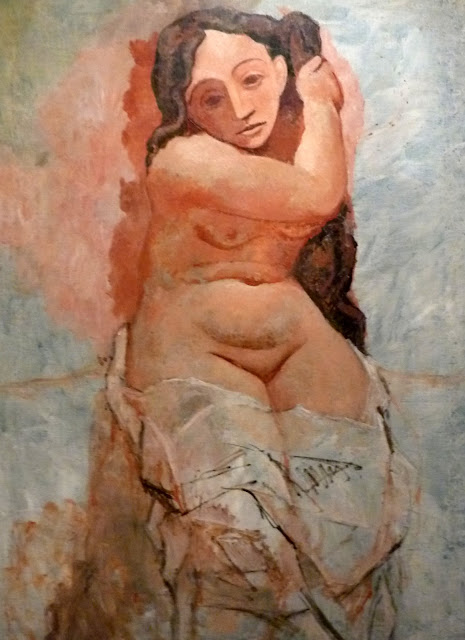While I was in New York, during my visit to the Museum of Modern Art, I looked at their collection of 19th and 20th century art and these are some of the pictures I took. I have categorised the art works according to the date they were produced.
19th century
Paul Gauguin, Washerwomen, 1888
Paul Gauguin, The Seed of the Areoi, 1892
Vincent Van Gogh, The Olive Trees, 1889
Vincent Van Gogh, Starry Night, 1889
Edvard Munch, The Storm, 1893
Paul Cezanne, Turning Road at Montgeroult, 1898
Early 20th century
Paul Cezanne, Chateau Noir, 1903-04
Georges Braque, Road Near L'Estaque, 1908
Pablo Picasso, Woman Plaiting Her Hair, 1906
Pablo Picasso, Two Nudes, 1906
Pablo Picasso, Les Demoiselles d'Avignon, 1907
Piet Mondrian, Composition in Brown and Gray, 1913
Diego Rivera, Jacques Lipchitz, (Portrait of a Young Man), 1914
Pablo Picasso, Repose, 1908
Pablo Picasso, Woman's Head, 1908
Pablo Picasso, Fruit Dish, 1908-09
Pablo Picasso, Violin and Grapes, 1912
Marcel Duchamp, Network of Stoppages, 1914
Marcel Duchamp, 3 Standard Stoppages, 1913-14
Jean (Hans) Arp, Enak's Tears (Terrestial Forms) , 1917
Marcel Duchamps, To Be Looked At (From the Other Side of the Glass), With One Eye, Close To, For Almost An Hour, 1918
Henri Matisse, The Rose Marble Table, 1917
Henri Matisse, Bather, 1909
Henri Matisse, Composition, 1915
Henri Matisse, Woman on a High Stool (Germaine Raynal) 1914
Pablo Picasso, Three Musicians, 1921
Amedeo Modigliani, Anna Zborowska, 1917
Amedeo Modigliani, Reclining Nude, 1919
Claude Monet, Water Lillies, 1914-26
Kazimir Malevich, Woman with Pails (Dynamic Arrangement), 1912-13
Kazimir Malevich, Painterly Realism of a Boy with a Knapsack - Colour Masses in the Fourth Dimension, 1915
Lyubov Popova, Painterly Architectonic, 1917
Kazimir Malevich, Suprematist Painting, 1916-17
Laszlo Moholy-Nagy, Construction in Enamel, 1923
These works and a third were fabricated in an enamel factory and they share an abstract geometric composition. It is likely that Moholy-Nagy made them shortly after his appointment to the Bauhaus in April 1923 as an articulation of the radical rejection of the handmade, unique artwork in favour of serial mechanical production. The artist later claimed to have dictated the specifications for these constructions by telephone, underscoring the role of the artist in the technological age as producer of ideas, not objects.
Piet Mondrian, Composition in White, Black and Red, 1936
Frida Kahlo, Fulang Chang and I, 1937
Frida Kahlo, Self-Portrait with Cropped Hair, 1943
Joan Miro, 'Hirondelle Amour' 1933-34
Jean Arp, Two Heads, 1929, painted wood
Joan Miro, The Birth of the World, 1925
Meret Oppenheim, Red Head, Blue Body, 1936
Piet Mondrian, Broadway Boogie Woogie, 1942-43
Alice Neel, Kenneth Fearing, 1935
Alexander Calder, Gibraltar, 1936
Dorothea Tanning, On Time Off Time, 1948
Late 20th century
Francis Bacon, Triptych, 1991
Louise Bourgeois, Sleeping Figure, 1951
Jasper Johns, Flag, 1954-55
Alberto Giaccometti, Annette, 1962
Helen Frankenthaler, Jacob's Ladder, 1957
Mark Rothko, No. 10, 1950
Francis Bacon, No. VII from Eight Studies for a Portrait, 1953
Christo (Christo Javacheff), Package On Wheelbarrow, 1935
Jackson Pollock, One: Number 31, 1950
Alberto Giacometti, The Chariot, 1950
Marisol (Marisol Escobar), LBJ, 1967
Donald Judd, Untitled (Stack), 1967
Dan Flavin, Untitled (to the 'innovator' of Wheeling Peachblow), 1968
Hannah Wilke, Marxism and Art: Beware of Fascist Feminism, 1977
Hannah Wilke, Ponder-r-rosa, White Plains, Yellow Rocks, 1975
looking closer
Eva Hesse, Repetition Nineteen III, 1968
Eva Hesse, Untitled, 1966
Lynda Benglis, Embryo II, 1967
Bruce Nauman, Untitled, 1965
Marisol, (Escobar), Love, 1962, plaster and glass, (Coca-Cola bottle)
Andy Warhol, Gold Marilyn Monroe, 1962
Andy Warhol, Orange Car Crash Fourteen Times, 1963.
Well done for getting to the end of this, a very long post, but I wanted to record some of the paintings and sculpture that I enjoyed but did not want to divide it into two posts!











































































So many fantastic works of art and all in one place (Your Blog,of course, but also the MOMA!). It must have been too much to take in during one visit. I think I'd have been exhausted.
ReplyDeleteThe collection really illustrates the dominance of American buying power during the 20th Century, But the money has gone elsewhere now.
Ha! Ha! Ha! My blog, of course!
DeleteIt was exhausting, but also tremendously exhilarating. That one day visit included not only the permanent collection (only a small fraction shown here) but also Diego Rivera, Cindy Sherman and the sculptures in the garden. Fortunately, we were allowed to photograph so I have a record of what was seen - I would have forgotten half of it otherwise.
The art in New York is incredible and again, because of exhaustion, there was so much more I wanted to see, but did not have the time. From early on, the decision was made not to go to the Metropolitan Museum of Art because there would be no time. I need to do four more posts of exhibitions visited which I have had no time to do - I keep telling myself that if I don't get my act together, it will be too late and I will have forgotten all about them.
As for the dominance of the American dollar, you are absolutely spot on. I fell in love with New York in a big way - it is so exciting - and the whole time I kept telling myself 'you are in the Metropolis' which I was, the imperialist metropolis and of course, it would be exciting and fabulous and overwhelming because the resources were there to make it what it is.
This comment has been removed by the author.
ReplyDelete